Despite the intense transformation of the past year, events continue to be what they have always been: a powerful opportunity to build an active, thriving community of brand advocates.
When it comes to event planning, planners and marketers who focus on creating a single, cohesive experience regardless of time, space, or channel will achieve just that. Our event planning framework for designing a blockbuster event is a proven, useful tool for creating just such an experience.
Event Planning: Creating a Shared Experience
For many years, participants were either in the same physical space, or they convened digitally. While the hybrid model has been in play for a while, it is only recently that there is a greater expectation to create an event delivered through multiple channels, leveraging virtual event capabilities to extend reach and add the flexibility and functionality that have the potential to improve the experience, the outcomes, and the measurability of events. Over the past year, the world has swung over to mostly virtual events, and event planners and marketers have done a brilliant job of pivoting to create immersive event experiences. The exciting question now is “What happens next?” as on-site events become possible again alongside the robust offerings of the virtual event that has been our lifeline for the past year or so. The beauty of this moment in time is that how we redefine “hybrid” is really up to you, the event planner. It’s an exciting time to be an event professional.
No matter how and where you plan to host your event, one thing is a constant: You are creating an event experience. When you think about it, effective event planning has always resulted in the creation of an immersive experience. Attendees generally come away feeling like a member of a community with a shared interest in something important to them. While they may each have experienced the event (and each other) through their own point of view, they are certainly aware of having shared some aspect(s) of it with others. And that sense of being a part of something relevant and communal is the payoff to all of your hard work, no matter what type of event you created. No matter what industry you are in, and no matter what type of event you have created, it has been with the intent and the outcome that likeminded people are sharing in the experience.
In every event, there are likely to be multiple audiences and multiple event objectives. And there are as many ways to create shared experiences when planning events as there are target audiences, meeting spaces, topics of interest, app features and platform capabilities. The key to success is designing the right combination so that all of your audiences are served in a way is meaningful and measurable.
And with the capabilities of a digital platform it becomes possible to extend the life of the event, even including an “always on” lifecycle if appropriate, such that there is pre-event and post-event engagement. Plus, there are so many ways to measure success, if you apply the right metrics. How do you adapt your event planning approach to make the most of all of this new opportunity?
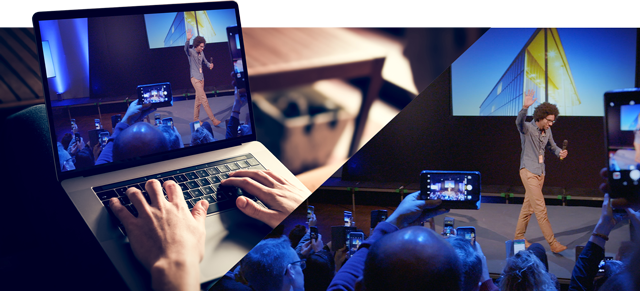
It’s clear: Whether you are planning an on-site event, a virtual event, or an event that combines both formats, effective event planning can be complicated. Designing an event that serves all of your audiences and achieves a complex set of goals can seem like a Herculean task. How do you approach something so complex? How do you know what to think about first?
Our event planning framework has helped many of our clients to design, deliver and evaluate immersive event experiences for their stakeholders— attendees, partners, sponsors, and content providers. We offer you this framework as a tool to help you think about setting goals, designing the experience that best meets event goals, delivering on the design and plan, and measuring your success, regardless of how and where you stage this shared experience.
Event Planning: The Shared Experience Framework
To help our clients stay focused during a time of such exciting (but sometimes distracting) opportunity, we have developed the Shared Experience Framework—a way of thinking about your event planning that will help you sift through the myriad options and opportunities available to you, and achieve a well-designed, impactful event.
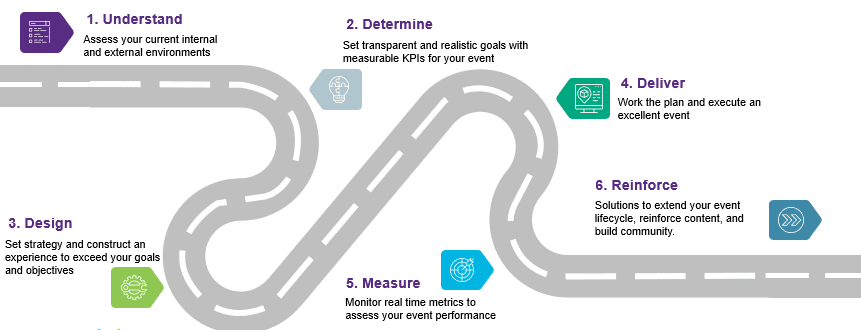
We have built the framework on six seemingly simple concepts:
- Understand (Assess your current internal and external environments.)
- Determine (Set transparent and realistic goals with measurable KPIs for your event.)
- Design (Set strategy and construct an experience to exceed your goals and objectives.)
- Deliver (Work the plan and execute an excellent event.)
- Measure (Monitor real time metrics to assess your event performance.)
- Reinforce (Extend your event lifecycle, reinforce content, and build community.)
The concepts may seem simple, but they are critical to building your event on a good foundation so that it does what it is intended to do, and so it is important to get them right. We’ll take you through each step to explain what we mean.
Understand: Fully review and understand the current internal and external environment you are experiencing. Assess the current state in the following areas to build a foundation for your event thesis.
- Market forces
- Team dynamics
- Past event performance
- Market dynamics
- Executive stakeholder expectations
- Financial and operational performance
- Other elements
The most important fundamental step you can take in the planning process is understanding the internal and external factors that may impact the design and overall viability of your event. Nothing underscores the potential impact of external forces on event planning like the COVID-19 pandemic which sent planners frantically in search of alternate solutions to physical meetings, and which sparked a technology leap that will likely have a lasting impact on how events are experienced from here on.
But there are other external influences which warrant consideration: market forces, which might affect industry behaviors, or market dynamics that drive behaviors like reduced company funding for participation or long-distance travel.
And when it comes to internal influences, there are many. Past event performance can significantly influence your plan. Prior success can mean an event that is growing exponentially and needs more resources; lackluster results can signal a need to revitalize/re-engineer your event design. Financial and operational performance will also drive design, with a potential to impact budget and cost management, human capital, technology upgrades, and your strategy for driving revenue. Team dynamics are vital to success, not just in the ability to collaborate and find synergies, but in understanding where the strengths and weaknesses lie, particularly as technology becomes more deeply imbedded as table stakes for successful events. And then there are stakeholder expectations, which may or may not be homogenous and harmonized, but which need to be identified, addressed and prioritized in the planning process.
Determine: Compelling goals with measurable KPIs for your event will be your “North Star” for event design. These goals will need to inspire and to be transparent and realistic to every stakeholder. Determine your goals for any of the following event elements which apply, and add any others, to ensure that your event is truly purpose-driven:
- Registration
- Attendance
- Content evaluations
- Speaker evaluations
- Exhibit engagement
- Content engagement
- Community engagement
- Revenue
- Partner participation
- Budget adherence
- Media impact
- Benchmarking
When determining goals and objectives, all of the work you did in the Understanding exercise should inform your assessment process and your decision-making. Each of your executive stakeholders will have a set of goals and objectives in mind and, depending on the number of stakeholders and the diversity of the interests they represent, you may have your hands full just finding a balance. Everyone will want everything, but even if you had infinite resources (Does anyone ever have infinite resources?) those external and internal influences over which you have limited control may get in the way. But finding that balance very early on in the event planning process will make the rest of the process less ambiguous and decisions easier to make.
Once you have done an audit of all the goals and objectives from your stakeholders, it is equally important to prioritize them. There will likely be conflicts and competition for resources (see “infinite resources” above), so being able to refer back to your well-prioritized list of goals will be a time saver and has the potential to reduce friction and stress. Be sure that everyone with a stake in the event has seen the prioritized goals and objective document, signed to confirm their acceptance, and has a final copy in their Inbox. Whenever there is a question of allocating resources, use this document as your guide and a roadmap for discussion and resolution.
Design: Work with your extended team to design an event experience based on your goals and desired outcomes. Adding virtual event elements to an on-site event offers an additional layer of options for creating a shared experience. Regardless of your format, consider this list of possible components and add any that may be missing but essential to achieving your goals:
- Speaker training programs
- Environment design
- Registration templates
- Promotion best practices
- Agenda planning
- Sponsor programs
- Gamification
- Content delivery best practices
- Engagement tactics
- Host & moderator formats
- Networking strategies
When designing the hybrid event, remember that you are designing two experiences—one for the physical/in-person participant and one for the virtual/remote participant. Be empathetic to how each will be experiencing your event. Give thought to what you want each experience to be, and where you want them to overlap. What content do they share? What is the entertainment experience that they share? Approach your design from outside in: Consider how the audience is experiencing it first, then think about which of those experiences you want them to share and how in the overall experience design.
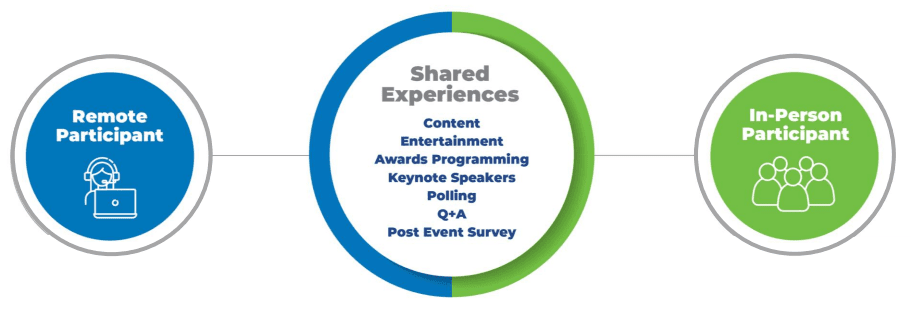
Assemble your event team to ensure you have the human resources necessary to deliver on your plan, not just by headcount, but by skill set as well. When designing a hybrid event, consider which resources will be allocated to virtual/in-person/hybrid. The mix will be particular to each event and should align with your event goals and objectives. If you don’t have the right resources and skill sets on your team, you will need to determine how to add them, either by making adjustments to your own team or adding external resources you can retain to fill the gaps. Your virtual event platform provider can be a valuable resource in determining which assets to use to achieve which objectives. Their extensive experience is built on finding solutions for many different types of challenges. Don’t overlook them as a valuable consultant and guide through every step of your planning process.
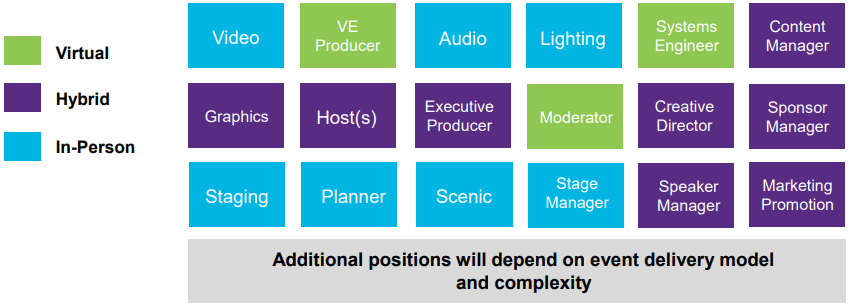
Deliver: Planning is nothing without execution. Plan your work, then work your plan. Once you’ve developed your plan and established your team, you need to deploy it in such a way that you achieve your goals. Consider how you can use people, virtual and physical space, and technology to make it happen before, during and after the main event, and for each of your target audiences, factoring in the virtual/remote audience with the physical where applicable.
-
Onsite event management
-
Production & AV services
-
Translation & captioning
-
Roving reporter
-
Hosted news desk
-
On the spot interviews
-
Content syndication
-
Enhanced social integration
-
Second Screen
-
Viewing Rooms
-
Mobile presenter capabilities
-
Entertainment (awards shows, happy hours, wrap ups)
-
Livestreaming of Keynotes
-
Breakout Sessions
-
1 to 1 Video Chat
-
Matchmaking
Don’t forget the pre- and post-event experience—a particularly strong advantage of having a virtual component.
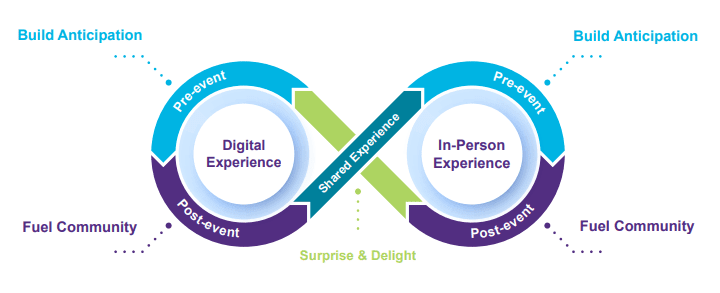
Before the main event starts, you have opportunities to deliver experiences that build buzz and excitement, even allowing registrants to contribute to the event planning and agenda. Here are just a few tactics you can use to raise awareness, build interaction and engage premium audiences for your event kicks off:
-
Define a strong multi-channel content strategy with event specific hashtags
-
Drive engagement and excitement in advance with a micro-event strategy such as new sessions added, new & VIP speakers, sneak peaks and “set the agenda” sessions
-
Promote networking and scheduling of meetings for the event in advance, including exclusive “meet the speaker” sessions
-
Create VIP or C suite closed group events to build community prior to live day with breakout sessions and networking
-
Share “Know Before You Go” materials in advance. Allow attendees to get familiar with how to make the most of the environment and experience
-
Include a countdown timer to build anticipation for the live event
When your main event is over, there is still a lot you can do to keep the conversation going by focusing on content and activities that both reengages attendees and attracts new audience members. Now that you have held the event, you have so much more content to work with! These tactics and others can help you extend the lifecycle and perceived value of your main event by turning new content into assets:
-
Create an on-demand library of all sessions for and remote audiences – include edited versions and highlight reels by subject or speaker, bite-size content for easy viewing
-
Add additional on-demand content on key takeaways or lessons learned to drive viewership
-
Create relevant post-event calls to action to further support your on-demand content
-
Host follow-on events such as Q&A sessions with key opinion leaders in the weeks immediately following your event
-
Run monthly community events and giveaways in the event environment
-
Turn the event environment into a “drop-in” client or sales center
With the right combination of physical and virtual, you can design an event that is “always on,” extending the life of your event for as long as there is activity to sustain it.
You have so many tools and tactics at your disposal. Which ones you choose to use will be driven by your goals and objectives, those external and internal influences as referenced above, and, of course, your budget. Bear one thing in mind: Behind many events there is the key driver and goal of growing your brand and your business. If you plan and design well, you have the opportunity to offset new expenses with new revenue from increased brand awareness, more leads, more direct revenue, and a longer-lasting, stronger relationship with your existing customers.
Whether you are hosting your annual conference, an investor day or a new product rollout, a well-designed event can lead to greater profitability. Even a hall meeting can have an impact on the bottom line through improved operational efficiencies; increased employee engagement, satisfaction and retention; and improved representation of your brand in the marketplace. Consider each element of your design in the context of how it can yield a return on investment or return on objectives, and then do your best to make sure your metrics can validate your decisions and expenditures. View our on-demand webinar Hybrid Events: Tactics to Blend the In-Person and Digital Experience to hear experts share tactics and other insights on creating a shared experience in a hybrid format.
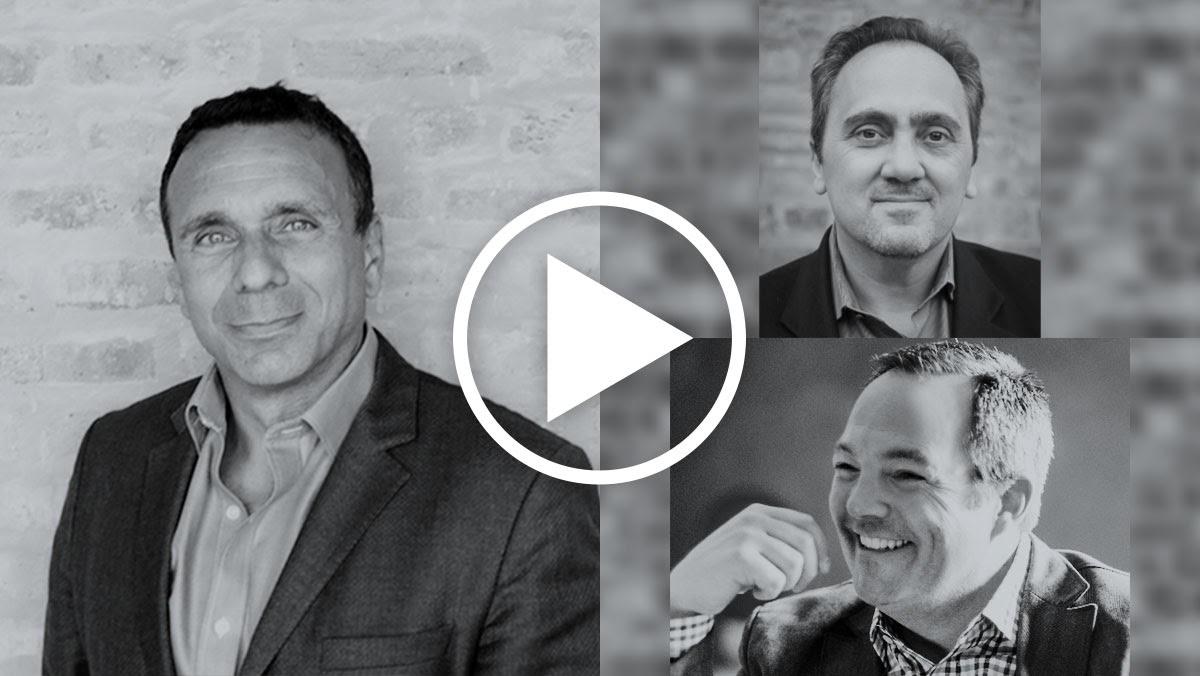
Measure: Having a flexible real-time dashboard of key performance indicators and insights will help you assess your event performance. Build your dashboard to accurately and clearly measure the indicators that tie back to your goals and objectives:
-
Access event statistics on-demand, in real time
-
Understand event performance over time
-
Benchmarks versus KPIs
-
Integration with third party platform data for physical and virtual attendee behaviour and performance
When you are in the Design phase setting your goals and objectives, it makes good sense to get input from your stakeholders on how they would measure success in meeting the event goals; this will help to ensure you are capturing and analyzing meaningful, actionable data. Here is the sample list we provided above of goals and objectives you might want to set. As you consider what data points will give you the best perspective on how well you did on each aspect you need to measure, remember that there may be varying levels of detail that you will want to capture to give you the level of detail and the clarity of insight you need to assess and communicate your results.
-
Registration
-
Attendance
-
Content evaluations
-
Speaker evaluations
-
Exhibit engagement
-
Content engagement
-
Community engagement
-
Revenue
-
Partner participation
-
Budget adherence
-
Media impact
-
Benchmarking
-
Sponsor engagement
-
Popular event spaces
For KPIs like registration, attendance, and various forms of engagement, having top-levels numbers just scratches the surface of measuring success. In addition to just counting registrations or attendance, you may wish to look at repeat vs. new, or analyze by demographic information, by price points, and by campaign. To fully understand engagement, a holistic picture of how your attendees engaged with content, in the exhibit area, and with other attendees can give you behavioral insights that can help you extend the value of your post-event activities and improve on your next event. The positive (and negative) of a virtual event platform is that there is an ocean of data that you can capture for analysis. For this reason, it is best to be very clear about what data has value, what you really need to capture and how best to analyze and report on it to your stakeholders and even your audience. Success stories make great sound bites for promoting your event internally and externally. You don’t want to find out after the fact that you missed an opportunity to gather and present compelling data that underscores your success (and gets you more budget and more resources for next time). If you’re not sure how to build the right analysis and report, engage your platform provider and other expert resources. Their expertise is priceless and well worth any investment you might make in having them at your disposal.
Reinforce: This is where you assess event performance and suggest/deliver additional solutions to meet and exceed goals and objectives. There are many ways to extend the life of an event when you design and plan well:
-
Post-event debrief
-
Tactics to drive on-demand viewership
-
Strategies to build community
-
Simu-live events to drive additional audience
-
Recommendations for future events
In this stage, all of the framework described above comes together to enable you to augment your success with opportunities for feedback, extended access to content, engaging new and repeat audience members, and insights that will inform your next event.
You gathered your stakeholders at the beginning of the event planning process. Be sure to reconvene with them during and after the main event. They can provide you with valuable feedback from the inside out, and may be a source of new ideas for how to keep the engagement and activity switched on while there is still time to do deploy. Some clients who manage multi-day events do a debrief at the end of each day; others, who deliver multi-session one-day events, keep an open dialogue via internal chat to debrief after each session or share insights and ideas about real-time opportunities for value-adding tweaks to the plan.
Having a plan for reinforcing the value of your content is crucial. Consider how you can use snips of your content (presentations, chat comments, newsroom social posts) to drive on-demand viewing (and even marketing of your next event). Incorporate simu-live events to bring in audience members who didn’t attend the main event. Remember: Every event is a shared experience. From beginning to end, you should have a plan for creating a sense of community among the attendees.
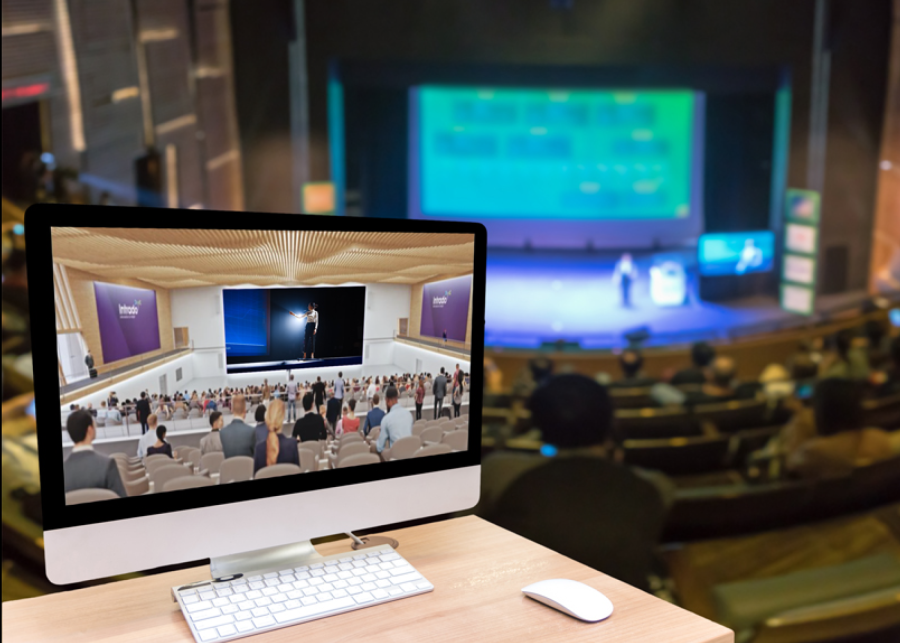
Summary
Times (and events) have changed, and event planners have the opportunity to build amazing events that leverage the return of in-person and the use of the much-improved functionality and applicability of virtual event technology. When you plan any event, you begin from the baseline of creating a experience for your participants including attendees, speakers, media, investors, employees, sponsors, and others who fit into your target audiences. What has changed of late is the likelihood that your audiences will have come to expect the flexibility and accessibility that digital technology affords, no matter what kind of event you are planning.
Planning an event has always required amazing skill and talent. Balancing stakeholder expectations with budget and human capital resources can be a tightrope walk. But it is that challenge that drives expert planners to push the edge of the envelope with every new event. Now that our audiences have experienced many of the capabilities of digital technology, there is a good chance they will be expecting that experience even when physical events have returned to a semblance of normal. Event planners will need to add virtual elements to their balancing expertise.
There is no question that creating a shared experience for an event that incorporates both physical and virtual—or even solely virtual—presents that maddening combination that comes with huge opportunity: making the right choices. The framework presented here is intended to help you frame your thought and event planning process in a way that yields outstanding results. We are often asked, “But, what about cost? Isn’t all this virtual technology expensive?”. We think it will be more costly in the long run not to make the most of new technology available for virtual events, and the opportunity it represents for improved scalability and flexibility. If you design a shared experience that informs and delights, with every element tied back to a business goal or objective, and with the ability to integrate, capture, analyze and measure meaningful data, the learnings and the quality leads and the direct revenue all add up to growth potential that would otherwise be left on the table.
If virtual event planning is still a new area for you, as it is for so many, make one of your goals this year to become more informed. You’ll be amazed at the opportunity that it represents for expanding the ways in which you as an event professional can add value to your company and to your own personal brand.
Get a Demo of Our End-to-End Event Platform
Whether you’re hosting virtual or hybrid events to reach customers, employees, investors, or partners, Notified is here to help bring your vision to life.
We host over 100,000 events annually on behalf of thousands of customers around the world while providing dedicated support with a focus on data.
All event solutions include:
-
Dedicated project manager
-
Interactive environments with live & on-demand programming
-
Flexible branding and personalization options
-
Accessibility – anytime, anywhere, and from any device
-
Robust analytics and reporting
And, from strategy and planning to implementation and delivery, our consulting services team supports you every step of the way.
Contact us today to set up a free demo and learn more about our consulting services.
